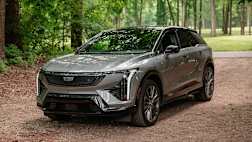What is the difference between 400-volt and 800-volt electric cars?
Doubling electric car voltage means that the time to charge up the EV’s battery pack will be effectively halved. An 800V system also means an EV’s cabling and electrical components can be thinner and smaller, resulting in a lighter, more efficient car.
Say what you will about petrol-powered internal-combustion engined (ICE) cars and their atmosphere-choking emissions, but there’s a certain joy knowing that filling up at the petrol station will only take a few minutes, after which you’ll have the opportunity to choose from a bountiful supply of overpriced snacks, should the mood take you.
It’s in stark contrast to getting an EV fully charged up which, at its absolute fastest, takes around 18 minutes. And at worst, several hours.
That can be a huge deterrent for people who are used to the convenience that comes with refuelling a gas guzzler, but it’s a problem that EV manufacturers are acutely aware of, and concerted efforts are underway to speed things up.
.jpg)
One solution is the development of new battery technology such as solid state and graphene batteries, the latter being 60 times faster compared to the commonly used lithium-ion cells in modern EVs.
The other solution is to change the electrical architecture of an EV from 400V to 800V.
Before we get into that, though, it might be worth looking at electric vehicle battery specifications and answering a few common questions.
How many batteries are in an electric car?
The quick answer? Lots.
If we’re going to get into the nitty gritty of it, every EV has a 12V lead-acid battery - just like ICE cars - that’s primarily used to power some of the electrical systems and accessories in the vehicle.
There’s also a lithium-ion battery pack that’s used to power the EV’s electric motor (or motors, if it has more than one), each pack typically containing thousands of individual cells.
.jpg)
How big is an electric car battery?
Size depends on how powerful the battery pack is. For example, a 17.6 kWh battery pack will be smaller than a far more dense 100kWh battery pack, which is what you’ll find inside an EV like the Tesla Model S.
What is the voltage of an electric car battery?
As previously mentioned, EV battery voltage is 12V for the lead-acid battery, and typically somewhere between 400-800V for the lithium-ion battery pack.
If you’re wondering “How many volts does a Tesla battery have?”, it’s 350V for the Model 3 and Model X, 375V for the Model S and 400V for the Model Y.
When it comes to hybrid electric vehicle battery voltage, that ranges between 100 and 300V, depending on the size of the battery.
400V vs 800V
A 400V architecture has been the norm for electric vehicles, but that’s set to change with the introduction of 800V systems, which can already be found in certain models from car manufacturers including Audi, Porsche, Hyundai and Kia.
The main drawback is that 800V architecture is more expensive to engineer, but that hasn’t stopped car brands from - if you’ll pardon the pun - charging ahead, with 800V predicted to become the standard for EVs by the time 2025 rolls around.
If you’re looking at 400V vs 800V charging, the latter is the clear winner, since it essentially halves charging time.
There are other benefits, too: the higher voltage creates a lower current, which reduces heat - always a good thing when it comes to EV batteries, as battery cooling systems can suck up power. Lower current also means charging cables can be thinner and less cumbersome, and certain electrical components in the car can also be thinner and smaller, making the car more lightweight and efficient.

800V charging
Paired with faster-charging solid state or graphene batteries, which are both still a few years away from seeing widespread deployment, 800V should be able to deliver a 10-80 per cent charge in 10 minutes or less - a huge improvement over current charging times.
Some ultra-rapid DC fast chargers have outputs of up to 350kWh, but that capability is lost on 400V EVs, since that level of output can fry batteries quicker than an egg on the surface of the Sun.
The battery pack in an EV with a 800V system has the lithium-ion cells connected in a series, a tweak that combats overheating and improves thermal efficiency, and also allows the voltage increase.
It’s worth noting, however, that an 800V EV is only handy when using a DC ultra-rapid fast charger with 300kW+ charge speeds, which currently aren’t in abundance in Australia, although more will be rolled out in the coming months and years.
.jpg)
EVs with 800V architecture
Models include the Porsche Taycan, Hyundai Ioniq 5, Genesis G80 EV, Kia EV6 and Audi e-Tron GT.
Other car manufacturers that have committed to an 800V architectures include Volvo, Polestar, Stellantis, General Motors, BYD and Lotus.
The Lucid Air EV takes things a step further with 900V architecture, making it the fastest-charging EV ever.






.jpg)
.jpg)



.jpg)
.jpg)

.jpg)
_0.jpg)







